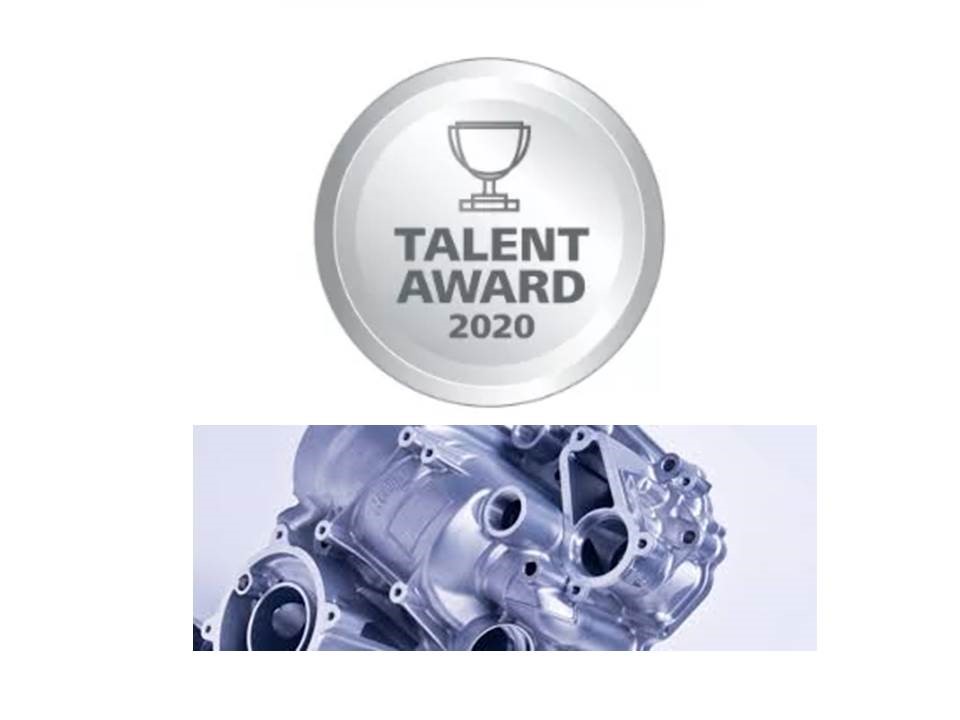

The International Aluminium Die-Casting award’s winner for 2020 has been declared. There were four casting awards at EUROGUSS 2020 in Nuremberg, while two others received special commendations.

The 9th International Aluminium Die-Casting Competition was organised by Düsseldorf-based Gesamtverband der Aluminiumindustrie e. V. (GDA). It was run in partnership with the German Foundrymen’s Association (Bundesverband der Deutschen Gießerei-Industrie, BDG), the Swiss aluminium Association (alu.ch) and the non-ferrous metals trade association of the Austrian Economic Chambers (Fachverband Nichteisenmetalle in der Wirtschaftskammer Österreich).
Die-casting has been the most successful industrial casting procedure for series or enormous production of structural parts for decades. The foundries of the of Die-casting have achieved its importance as suppliers towards automobile manufacturers, companies engaged in mechanical and plant engineering and other branches of industry, such as communications technology, the furniture industry and the electrical and electronics industries.
The development of ever-newer die-cast components is proceeding rapidly. Whether it is structural elements, parts for electric cars or intelligent components for conventional vehicles, attempts are being made everywhere to make use of the outstanding options that die-casting has to offer.
The International Aluminium Die-Casting Competition has been a successful platform to bespeak the high standard of quality of aluminium die-casting for many years. The competition aims to intensify interest in the versatile material aluminium and to highlight innovative areas of use. The criteria for evaluating the castings submitted to the International Aluminium Die-Casting Competition 2020 were compatibility with the die-casting process and the re-source-efficiency of the design.
A jury of experts from research and practice awarded prizes to the following six entries.
The winners are:
1st Prize: Oil-coolant module
Hengst SE, Nordwalde, Germany
Alloy: AISi9Cu3(Fe)
Weight: 8 655 g
Dimensions: L 443 mm, W 340 mm, H 195 mm
The first prize is being awarded for the consistent development methodology used from the design of the casting via the tool design through to the casting process, and which has no taboos and is aimed at achieving optimum results. Decisive aspects were the complex geometry, with inner slides and the smallest possible remoulding drafts and low tolerances, which at the same time meets the most exacting demands for pressure tightness. The intensive tempering using all technical means available is particularly impressive.
2nd Prize: Housing for HV booster
Druckguss Westfalen GmbH & Co. KG, Geseke, Germany
Alloy: EN AC-AISi10MnMg
Weight: 2 785 g
Dimensions: L 344 mm, W 365 mm, H 176 mm
The winner of the second prize is a die-casting with a large number of integrated functions that are subject to the most stringent sealing requirements because it has water-conducting cooling zones arranged next to zones with electricity at high voltage. Despite the thin wall thicknesses, high stiffness and dimensional accuracy were achieved using stiffening ribs. The low-copper aluminium alloy used ensures the part has high corrosion resistance and strength in the as-cast condition.
3rd Prize: Upper part of the housing for dual-channel EBS
Alupress AG, Brixen, Italy
Alloy: EN AC-47100
Weight: 780 g
Dimensions: L 193 mm, W 98 mm, H 98 mm
The winner here is a die-casting that must comply with stringent safety requirements. The aluminium die-casting has won through against injection-moulded plastic parts thanks to dimensional accuracy, with the smallest of tolerances and minimum radii, permeability and the good finish of the as-cast sealing surface. Remarkably, the as-cast part is ready for assembly. The innovative and efficient tempering system with additively manufactured mould segments was also rated highly.
3rd Prize: Battery housing
Nemak Slovakia s.r.o., Žiar nad Hronom, Slovakia
Alloy: AlSi9Mn (non-heat-treatable alloy)
Weight: 15,900 g, Casting with extruded baseplate: 38 000 g
Dimensions: L 1 045 mm, W 753 mm, H 218 mm
Another third prize is going to a hybrid battery housing cast on a 4400-tonne machine using a complex 3-platen tool with four outer slides and a vacuum die-casting process. The casting is joined by friction stir welding to three extruded profiles that form the base of the housing. This provides the best possible guarantee of adherence to the stringent tightness requirements (helium tightness test). The use of a non-heat-treatable alloy eliminates the need for thermal treatment.
Special Commendation: Housing components for the electric-vehicle control device
Alupress AG, Brixen, Italy
Alloy: AISi12(Fe)a
Weight: 1 450 g
Dimensions: L 350 mm, W 175 mm, H 70 mm
This casting is receiving a special commendation for the savings of up to 30% on installation space and weight that result from the integration of a large number of functions. The casting has an intelligent liquid cooling system with a laser-welded housing cover. From a design point of view, this meant adapting the original design and reducing the mass locally. A significant reduction in cycle time could be achieved by the use of laser welding for joining. Furthermore, the overall concept provided a cost-effective solution.
Special Commendation: String inverter
FBL Pressofusioni srl, Vobarno, Italy
Alloy: EN AC-46000
Dimensions Inner parts (2) L 533 mm, W 386 mm, H 266 mm Weight: 9 700 g / 9 600 g
Dimensions Outer parts (2) L 705 x / 704 mm, W 527 x / 527 mm, H 150 / 150 mm Weight: 12 000 g / 7 000 g
A four-piece string inverter with a large number of integrated functions and mounting options for the internal electrical components is also receiving a special commendation. The castings are characterised by deep ribs to cool the housing. The consistent method of developing the casting system to reduce porosity or distribute it to a non-critical area is also highly commendable.



Responses






